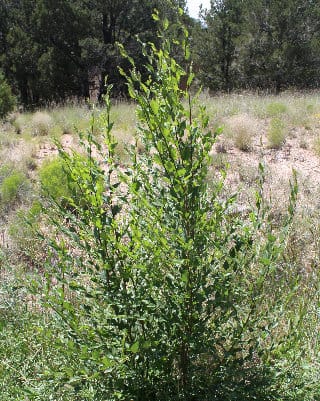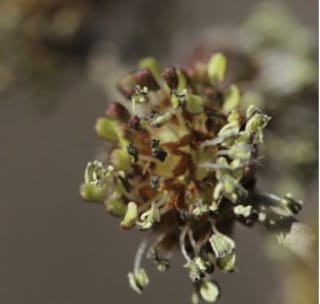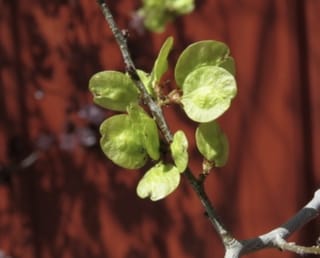This guide initially displays all weeds in the Los Alamos area classified in NM as noxious regardless of shape. Use the selectors below to include nonclassified weeds or select a specific set, either by shape or name.
The term weed is commonly used to denote a plant that is growing in an area where it is not valued. It is officially defined by the USDA Animal and Plant Health Inspection Service as being any plant that poses a threat to agriculture and/or a natural ecosystem. A noxious weed is one that is particularly troublesome and can directly or indirectly injure or cause damage to crops, livestock, or natural resources.
In general, plants that are within their native range live in balance with their environment and are not typically considered to be weeds. Issues can occur, however, if a plant is introduced, either directly or indirectly, to a new ecosystem. These, now non-native plants, may be able to thrive in their new environment. If so, these naturalized plants can fall into one or two categories long term: (1) plants that are valued for their flowers and fruit and (2) plants that are rapidly considered to be weeds. The plants in the latter category are those that are generally regarded as noxious weeds.
While some species shown here are included in the PEEC Flower and Tree Guides, this guide concentrates on some of the nastier introduced species that you might see in your yard or on local trails. In addition, this guide includes some native plants that meet the general definition of weed.
Weed References
A Plan For the Control of Invasive Species on Los Alamos County Open Space — Craig Martin [PDF]
Los Alamos Master Garden Weed List
NMSU Weed Information
SEINet: Southwest Biodiversity
Some Common Lawn and Garden Weeds of Los Alamos, NM — Dorothy Hoard and Teralene Foxx [PDF]
Troublesome Weeds of NM
USDA: Introduced, Invasive, and Noxious Plants
Weed Alert
Weeds of the Los Alamos Area — Teralene Foxx [PDF]
Subject Area Experts (all guides)
Steve Cary (butterflies)
Beth Cortright (insects)
Terry Foxx (invasive plants)
Leslie Hansen (mammals)
Richard Hansen (fish, mammals)
Dorothy Hoard (butterflies, trees)
Chick Keller (flowers, herbarium)
Shari Kelley (geology)
Kirt Kempter (geology)
Garth Tietjen (reptiles)
David Yeamans (birds)
Web Development and Content Management
Pat Bacha
Jennifer Macke
Graham Mark
Akkana Peck
Contact
Please contact us for local nature questions and sightings. We welcome comments, corrections, and additions to our guides.
For more information about local nature, please visit our Nature Blog or subscribe to PEEC This Week.
Make Selection
 Photo: Akkana Peck  Photo: Nathan Taylor  Photo: Brandt Magic |  Siberian ElmULPU (Ulmus pumila)Family: Ulmaceae (Elms) Size: 600 - 840 in (1,524 - 2,134 cm) Growth: shrub, tree; perennial Status: non-native; classified weed (common) Native Range: central Asia NM Noxious Weed Class: C - widespread Habitat: on disturbed ground and abandoned lots, along railroad tracks, near field windbreaks, and close to vacant buildings Control Notes: pull/dig up seedlings and small trees; girdling can be effective for mature trees in late spring to mid-summer, otherwise herbicides are required Ulmus pumila has been widely cultivated both in its native range and in a large number of places world wide for its rapid growth and drought tolerance. It is thought to have been introduced into the US in 1905. The trees were cultivated at the USDA Experimental Station in North Dakota. They flourished there and were subsequently selected by the USDA for planting in the aftermath of the Dustbowl. Unfortunately, the plant is quite invasive in cities and open areas and has been classified as invasive in a large number of states. Fortunately, it rarely invades mature forests. The Siberian Elm is a small to medium-sized tree or a tall bushy shrub. The bark is dry gray and irregularly fissured. Leaves are elliptical and change from dark green to yellow in autumn. The green and brownish-red flowers are rather small. The fruit is flat, round, and paper like. Each fruit or samara contains a single seed. A impressive local example of a Siberian Elm can be seen in Santa Fe at the Palace of the Govenors. The Siberian Elm is of interest to botanists due to its resistance to Dutch elm disease. This has lead to the development of several hybrids between Ulmus pumila and other elm species trying to create a tree with a more native appearance but strong resistance to Dutch elm disease. In addition, as the area is getting drier and hotter, researchers are beginning to think that the Siberian Elm may be value when the native trees starting to die off. Info Photos Distribution Tree Guide |
